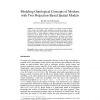Free Online Productivity Tools
i2Speak
i2Symbol
i2OCR
iTex2Img
iWeb2Print
iWeb2Shot
i2Type
iPdf2Split
iPdf2Merge
i2Bopomofo
i2Arabic
i2Style
i2Image
i2PDF
iLatex2Rtf
Sci2ools
KI
2008
Springer
2008
Springer
Modeling Ontological Concepts of Motions with Two Projection-Based Spatial Models
To model human concepts of motions is essential for the development of the systems and machines that collaborate with ordinary people on spatiodynamic tasks. This paper applies two projection-based spatial models, Double Cross and RfDL3-12, to the modeling of human concepts of motions on a plane, making use of the ability of these two models to illustrate where and how a landmark extends around/on a path. For generalization, we adopt a set of formal motion concepts defined in an existing spatial ontology called GUM. These motion concepts are associated with the motion patterns modeled by Double Cross and RfDL3-12, considering two scenarios where the landmarks are represented by points and regions, respectively. For the latter scenario, we identify the motion patterns whose characterization cannot be clearly determined. In addition, we find that the knowledge of landmarks' convexity is useful for characterizing motion patterns. Keywords. motion concepts, route descriptions, project...
Artificial Intelligence | Double Cross | Human Concepts | KI 2008 | Projection-based Spatial Models |
| Added | 13 Dec 2010 |
| Updated | 13 Dec 2010 |
| Type | Journal |
| Year | 2008 |
| Where | KI |
| Authors | Hui Shi, Yohei Kurata |
Comments (0)

